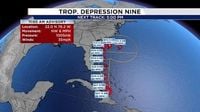As the Atlantic hurricane season powers toward its annual peak, residents along the southeastern coast of the United States are bracing for the arrival of a new tropical threat: soon-to-be-named Tropical Storm Imelda. Over the weekend of September 27-29, 2025, what began as Tropical Depression Nine in the Caribbean is expected to strengthen, bringing with it a host of weather hazards for the Bahamas and the U.S. coastline from Florida to the Carolinas. The National Hurricane Center (NHC) and meteorologists across the region are urging vigilance, even as the outlook shifts hour by hour.
According to the NHC, as of Saturday afternoon, September 27, Tropical Depression Nine was located northwest of the eastern tip of Cuba, moving northwest at about 7 mph with sustained winds of 35 mph. The system was forecast to cross the central and northwestern Bahamas during the weekend, bringing tropical-storm-force winds and heavy rain. A tropical storm warning was issued for most of the Bahamas, and a tropical storm watch stretched along Florida’s east coast from the Palm Beach/Martin County line up to the Flagler/Volusia County line, including Brevard, Volusia, and Flagler counties (ABC News, News 6 Orlando, USA Today).
By Sunday through Monday, the storm—likely to be officially named Imelda by then—was expected to track north through the Bahamas, paralleling the east coast of Florida. The NHC projected that the system would remain offshore but close enough to generate rough surf, a high risk of rip currents, gusty winds up to 40 mph, and scattered heavy rain along the Florida coast. While peak sustained winds for Florida were forecast between 15-30 mph, with gusts up to 35 mph, additional rainfall of 1 to 3 inches was possible, with some areas potentially seeing even higher totals. The risk of storm surge flooding in Florida was considered minimal, but the threat of beach erosion and dangerous surf remained high (News 6 Orlando).
As the system moves north, the forecast becomes more complex. Weather models have begun to align, suggesting Imelda will slow as it approaches the coasts of Georgia and South Carolina by Tuesday, September 30, possibly as a strong tropical storm or a weak Category 1 hurricane. At this point, the heaviest rain and strongest winds are expected to buffet the Carolinas, with storm surge and coastal flooding possible for the first half of the week (ABC News).
One complicating factor is a stalled front draped over the Southeast coast, which is expected to interact with Imelda and allow for multiple days of rainfall from Georgia up to Virginia. The NHC warned that this could result in flash, urban, and river flooding, particularly in the Carolinas and southern Mid-Atlantic states. Rainfall amounts of 3 to 6 inches are possible, with localized totals of up to 10 inches across portions of the coastal Carolinas (USA Today).
Despite the increasing likelihood that Imelda will remain offshore and avoid a direct landfall, officials are not taking any chances. South Carolina Governor Henry McMaster declared a statewide state of emergency on Friday, September 26, in anticipation of the storm’s impacts. "As this storm approaches our coast, I am issuing a State of Emergency to ensure Team South Carolina is able to access and deploy the resources and personnel needed to prepare for and respond to this storm," McMaster said, as quoted by USA Today. "While the storm's arrival, speed, and intensity remain hard to predict, we do know that it will bring significant wind, heavy rainfall, and flooding across the ENTIRE state of South Carolina. We have seen this before. Now is the time to start paying attention to forecasts, updates, and alerts from official sources and begin making preparations."
In an afternoon press conference on September 27, McMaster emphasized that there were no mandatory evacuation orders but warned residents not to be complacent. "We know that we're going to have high winds, we know that we're going to have a lot of water," he stated, drawing a comparison to Hurricane Helene a year prior. "This storm does not look as strong as it looked yesterday, but that could change tonight." He urged the public to avoid driving through standing water, noting, "Don't drive through standing water… we lose a lot of people through drowning. That's pitiful."
Local governments are also taking preventative action. The city of Charleston, South Carolina, issued a local state of emergency "out of an abundance of caution," with Mayor William Cogswell stating, "Today’s action is about readiness. Our teams are clearing drains, staging pumps and barricades, and adjusting staffing so we can respond quickly if conditions worsen." In North Carolina, Governor Josh Stein declared a state of emergency as well, further underscoring the widespread concern across the region (ABC News).
Meanwhile, another major player is swirling in the Atlantic: Hurricane Humberto. Over the same weekend, Humberto rapidly intensified to become the third major hurricane of the 2025 season and the second Category 5 storm of the year. With maximum sustained winds of 160 mph and a minimum central pressure of 925 mb, Humberto is forecast to remain west of Bermuda through Tuesday and Wednesday, staying hundreds of miles from the U.S. mainland before turning northeast and heading out to sea. However, Humberto’s presence could influence Imelda’s path through a phenomenon known as the Fujiwhara effect, in which two nearby cyclones interact and can alter each other’s trajectories—sometimes causing one to be absorbed or both to spin off in new directions (USA Today).
Forecasters caution that the situation remains fluid. The upper-level low that might have drawn Imelda into the Carolinas is weakening, and Hurricane Humberto could help steer the storm farther out to sea by midweek, potentially reducing wind and rain impacts for the Georgia and Carolina coasts. Still, as News 6 Orlando noted, "things can change quickly. Stay alert and check for updates." The NHC echoed this advice, reminding residents from Florida to North Carolina to monitor official forecasts and ensure their hurricane plans are ready.
The memories of Hurricane Helene, which struck just a year earlier, linger fresh in the minds of many coastal residents. Helene’s rapid intensification and unexpected path left lasting scars from Florida to Tennessee, reinforcing the lesson that even a single storm can have outsized and unpredictable consequences. As the NHC put it in a recent advisory, "It only takes one storm to make it an impactful year for your community."
With the Atlantic hurricane season running through November 30 and the most active weeks still ahead, experts at Colorado State University are predicting continued tropical activity. Residents along the Atlantic seaboard are reminded to prepare early, stock up on essentials, and heed the warnings of emergency officials. Whether Imelda ultimately makes landfall or not, the message from authorities is clear: caution and readiness are the best defenses against the unpredictable power of nature.





